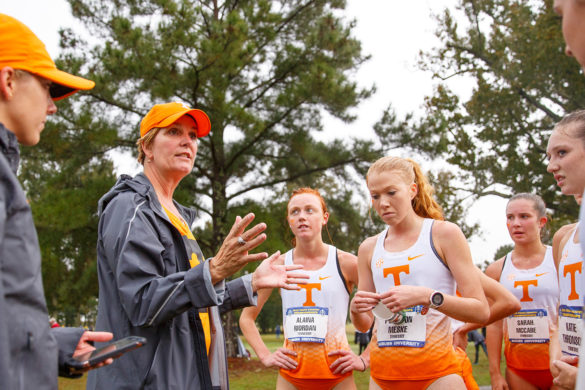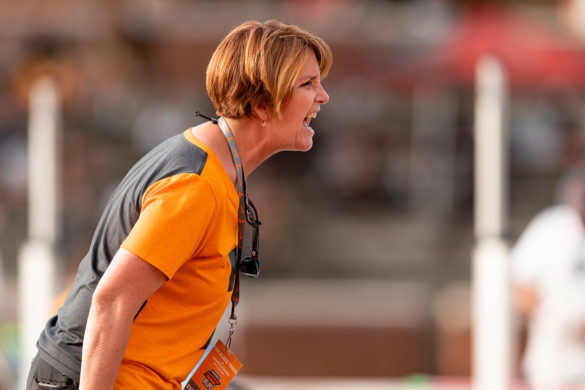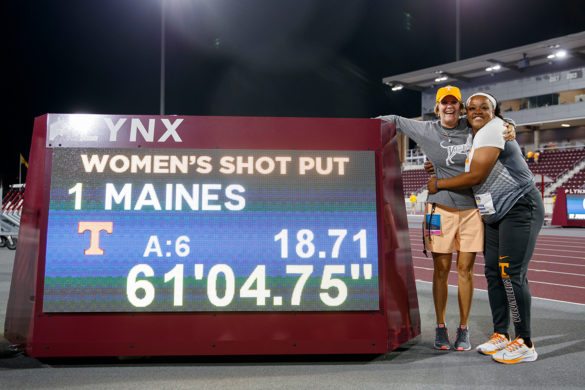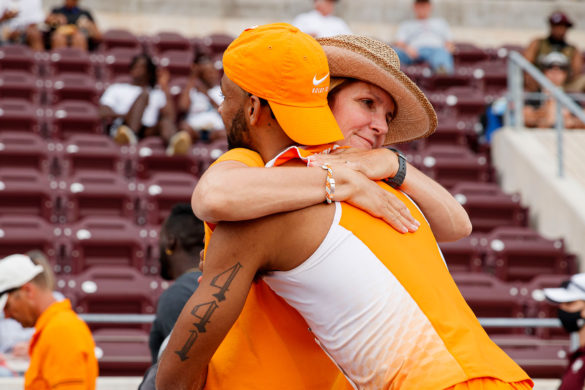The Olympic Games in July 2021 featured 11 current and past Vols and Lady Vols, bringing UT’s total number of Olympic competitors to more than 120. Impressive as it is, that count doesn’t include the important contributions of coaches and other staffers behind the scenes—such as Director of Track and Field Beth Alford Sullivan, who’s coached seven Olympians in her time at UT.
Beth Alford Sullivan sits inside her office at the Brenda Lawson Athletic Center with a humble confidence and a list of new tasks she aspires to achieve. A competitor and challenger mentality, Sullivan said, is in her DNA.
As the director of track and field and cross-country for the University of Tennessee, Knoxville, Sullivan has shattered glass ceilings inside the Southeastern Conference—becoming the first woman in its history to lead a men’s team in any sport.
Before Sullivan began traveling down historic roads, her love for track and field was born in her hometown of Minnetonka, Minnesota. With her father having played baseball as a member of the University of Minnesota’s 1960 national championship team and her brother following his own passion for baseball, Sullivan had plans to continue the trend.
“It was probably around junior high when softball was an option for girls. So I started out in softball thinking I was gonna be a great softball player, and did that and played summer league all the way through,” Sullivan said.
It wasn’t until a physical education teacher saw Sullivan run that she began to consider track and field.
“He recruited me, and I’ve been with it ever since,” Sullivan said. “I wasn’t really built to play softball all that well, and certainly track found me, I found it, and it was the shoe that fit.”
Just as Sullivan saw softball first being offered during her junior high years, she continued to see the evolution of women in sports while competing as a distance runner for the University of Minnesota and into her postgraduate career.
Women didn’t enter the NCAA arena, Sullivan recalled, until 1982. Before then, there were no NCAA women’s championships, and most collegiate women competed under an organization called the Association for Intercollegiate Athletics for Women. Just two years after the transition, Sullivan graduated from Hopkins High School.
“We were relatively new to NCAA sports. So I really was in the first phase of women to come under the NCAA umbrella. I’ve seen it evolve all the way through.”
Leadership roles started for Sullivan as she became captain of the University of Minnesota’s cross-country team. During her fifth year at the university, the rookie runners took notice of her ability to lead.
“I was back [in my fifth year] running for the team, and one of the freshmen and I were on a run and she said, ‘You should major in running,’” Sullivan said with a laugh. “But it was the first day that I wondered: how do you become a college coach?”
Sullivan started asking her coach questions about how to enter the collegiate coaching field. With no pathways at the time such as sport management degrees, her coach told her she’d need to go to graduate school and become a graduate assistant to get her feet wet. As a social work major, Sullivan had visions of helping troubled youth, and in some ways these visions would come true—only the youth she would later work with were athletes who would turn into champions, Olympians, and record breakers.
Sullivan’s curiosity for coaching was piqued that day, but now she has experienced a wide range of success as a collegiate track and field and cross-country coach. These experiences range from being an assistant coach at Southeast Missouri State University and receiving her first head coach position with the women’s team of Mankato State University (now Minnesota State University, Mankato) to becoming Stanford University’s women’s coordinator at Stanford and then the women’s head coach at Penn State.
She moved up the ranks at Penn State to become director of track and field and cross-country. The position made Sullivan the first woman ever to lead a men’s Power Five track and field program. Now she’s here on Rocky Top, bringing the same historical transformation to the SEC.
Sullivan’s success shatters gender stereotypes in the sports world. Many professional runners and athletes, however, have spoken up in the past year against the lack of women in leading coaching positions. It could be argued that this recent peak of advocacy inside women’s running could be traced back to phenom Mary Cain, who in 2013 became the youngest athlete to compete on a world championships team.
Cain—a high school athlete competing alongside (and beating) professional women twice her age—joined American track coach Alberto Salazar and his all-male staff to compete professionally as part of Nike’s now-defunct Oregon Project. To become faster, Cain’s coaches believed, she needed to get thinner.
“I got caught in a system designed by and for men, which destroys the bodies of young girls,” Cain said in a 2019 New York Times op-ed video. “There is a systemic crisis in women’s sports, in which young girls’ bodies are being ruined. . . . We need more women in power. Part of me wonders if I’d worked with more female psychologists, coaches, and nutritionists, where I’d be today.”
Sullivan paid attention to Cain’s journey, as well as other professional female runners who told their own stories of male coaches with similar training philosophies.
“I’m a big believer that any gender can do anything, right? That it’s not limited by gender,” Sullivan said. “And I think the platform being used—it’s very honest; it’s very true what Mary Cain has gone through and what others have gone through.
“I know more people have come out since then on their experiences. And I think those things are very real, but at the same time, I think they’re using the platform in a positive way to say, ‘Hey look, we have a discrepancy. There should be more women in our coaching.’ So, I think that that’s a positive that spins out of a negative, and hopefully that is heard and done.”
Sullivan also thought back to the time when women joined the NCAA in the early 1980s and how this affected women in leadership positions.
Running is different than many other women’s sports like softball and basketball, she said, in which there are many women head coaches. When men and women began competing in track and field together in the early 1980s, leadership roles for women declined.
“We’re a different sport than many of our other women’s sports in softball and basketball. There’s a lot of women head coaches. When we went from separate to combined in the early ’80s, there was a big loss of women in leadership roles for our sport especially,” Sullivan said.
“We’re trying to climb back up and knock down that glass ceiling and make something happen. But it’s still a lot of work, and so in the running community, people feel it.”
For Sullivan, though, she’s never felt that her gender has held her back. She notes that when she took over as director at Penn State, out of a roster of over 70 male athletes, only one chose to leave the program.
“I really give a lot of credit to those first classes that I inherited who weren’t my recruits,” Sullivan said. “Because they looked at it as a great opportunity and rolled with it.”
Taking on the position of director of track and field and cross-country at Penn State prepared Sullivan for what she considered the ultimate step—making it to the SEC.
“As a coach, if you strive to be good, especially, you know what the next step is,” Sullivan said. “And the SEC is the next step. It’s the ultimate step. To coach in the SEC is pretty phenomenal, especially to be a director or head coach.”
Having coached alongside her husband throughout her career, Sullivan said she joked with him that the only place they would leave Penn State for would be UT.
“We aren’t southerners and couldn’t go to Florida, couldn’t go to Georgia,” Sullivan said with a smile.
She and her husband had been to Knoxville frequently for competitions and liked what they saw. So when the head track and field coach job opened up and UT called her, Sullivan knew she couldn’t pass up the opportunity.
“I explained it to my Penn State team and my friends that a challenge is kind of in a coach’s blood, and whenever you get an opportunity to have a challenge that’s the next step forward, it’s hard to say no,” Sullivan said.
“I felt like it was in my DNA to take on the next challenge and to break down some barriers and say, ‘Hey, we can do this. Let’s go.’”
That challenger mindset and “let’s go” attitude are mentalities Sullivan hopes to instill in her athletes. At the end of the day, she wants them to be the best people, students, and athletes they can be.
“It’s not a natural thing to wake up and think about how I can empower my team to look beyond themselves or do something that no one else has done before. It’s, more or less, you realize that you have an impact and you have to value that and take advantage of teaching and inspiring at the same time.”
“What I try to do with my staff and my team is continually say [that with] hard work and determination, you’re gonna create your own breaks. My favorite quote is ‘Luck is the residue of design,’ and if you design it, you’re gonna get some luck off of that. If you live it and design it and breathe it, it’s gonna come back and give you a little bit of luck. That’s been a big motto of mine—creating the image and going after it.”
For the athletes on her UT roster, Sullivan has specific goals in mind before they graduate and leave her program.
She desires for them to maximize their academic career and become the best champions and leaders they can be, impacting their communities and making differences in the world. Those goals are made evident by men’s and women’s program records for highest GPA, as well as record high numbers of track and field athletes receiving All-Academic Individual honors from the U.S. Track & Field and Cross Country Coaches Association and SEC Academic Honor Roll certificates under Sullivan’s guidance. For the past five seasons, both the men’s and women’s teams have garnered All-Academic Team awards.
“I look at them and see if they’re scholars, champions, and leaders. And if they are, I’ve met my goal and my time with them, and it’s pretty rewarding.”
Even with all of her success as a coach—racking up 32 Coach of the Year awards, coaching NCAA and conference individual champions, shaping athletes who move on to become Olympians, and helping to rebuild a program at UT—she’s not ready to take her foot off the gas pedal anytime soon.
“It’s been a tremendous ride, and we’re settled in now. We’re seven years in now and we’re seeing our hard work play out,” Sullivan said. “And we’ve got a lot of tasks yet to achieve.”
Photos By Caleb Jones, Andrew Ferguson, Brian Woolston, Amanda Pruitt /Tennessee Athletics






1 comment
An inspirational story and role model for all leaders ! Our daughter is a student athlete in her system and we can attest she is a caring, competitive and genuine leader. Thank you and congrats Beth.